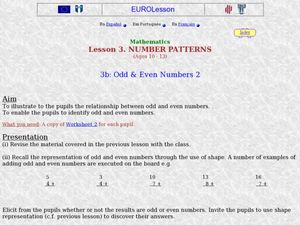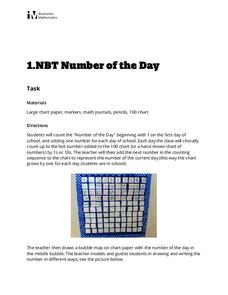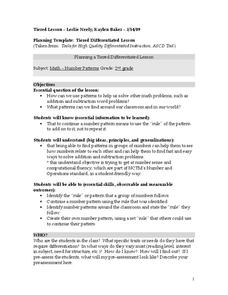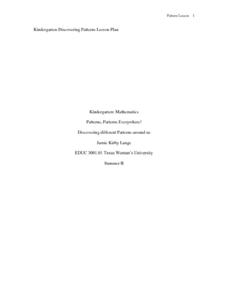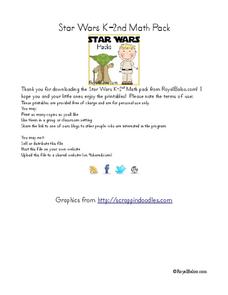Curated OER
Number Patterns
These patterns are perfect for learners brand new to counting. They examine 9 number sequences, completing the last two numbers. The codes are easy to crack here- they count by 1, 2, and 3. For a bonus sequence, scholars count by 10....
Curated OER
Number Patterns
Help your students to identify even and odd numbers. In this number sense lesson, they read the book Madeline and use counters to identify which number has a "partner." Learners write down odd and even numbers on a whiteboard.
Curated OER
Patterns
Follow the pattern to find what comes next. Youngsters analyze shape patterns to continue the sequence in the provided space. The three patterns increase in difficulty, and then scholars have a chance to create two of their own....
Oddrobo Software
King of Math Junior
Do your students have what it takes to be the king of math? Find out with this fun skills practice game that covers a wide range of topics from counting and basic operations to measurement and fractions.
Curated OER
Number Patterns/ Odd and Even #2
What's odd? What's even? And what is the pattern? Learners explore addition problems to answer this question, deciding if the answer to each equation is odd or even. They then draw a two-column table to illustrate the outcomes of the...
Curated OER
My Test Book: Math Review
Test that number sense with this 10 question quiz. This quiz contains 10 questions intended to assess how well second graders understand standard form, expanded form, number patterns, and numeric quantity or value.
Curated OER
Pattern Practice
Finishing patterns can be fun and engaging. Here are nine different patterns that have learners determine the rule or determine which image or shape will come next in the sequence. A very well-done presentation.
Curated OER
Naming the Pattern
In this pattern activity, 2nd graders complete fifteen number patterns and explain the counting pattern for each group. Students also complete five picture patterns and label each of the patterns.
Curated OER
Symmetry of the Addition Table
Help your class discover the commutative property of addition with this exploration of the addition table. By folding and coloring the table, a symmetry is found that directs learners to an understanding of this crucial mathematical...
Curated OER
Number Patterns
Spot the pattern! Pupils examine nine patterns using numbers 0-13. There are two blanks for learners to complete the pattern. None of these involve difficult math or complex concepts- this is for young pattern-finders. A...
Illustrative Mathematics
Number of the Day
Daily routines not only help to manage classrooms, they can also provide learners with rich opportunities for learning. This activity supports young learners in developing their number sense by counting up the school days on a class...
Granite School District
Activities that Build Number Sense
Have fun while building the number sense of young mathematicians with this list of ten-frame learning games. From developing cardinality and counting skills to learning place value and basic addition strategies, ten-frames are excellent...
Resources for Educators
Math & Science Connection
Whether you're using a collection of Dr. Seuss books to teach basic math skills like counting, adding, and subtracting, or exploring the different states of matter by melting a crayon with a hairdryer, a series...
K-5 Math Teaching Resources
Pattern Blocks
Who needs to buy pattern blocks when you have this printable pattern block template? Including triangles, squares, trapezoids, rhombuses, and hexagons, this resource offers endless possibilities for teaching children about geometric shapes.
Public Schools of North Carolina
Math Stars: A Problem-Solving Newsletter Grade 2
Develop the problem solving skills of your young learners with this collection of math newsletters. Covering a variety of topics ranging from simple arithmetic and number sense to symmetry and graphing, these...
Scholastic
Cracking the Code
Can you figure out the code? Learners interpret ten number patterns and write the five numbers that come next. Next, they create their own number patterns based on their own codes.
Illustrative Mathematics
Equality Number Sentences
Understanding the concept of equality is fundamental to the success of young mathematicians. To explore this basic idea, children compare the dots arranged in pairs of rectangles in order to determine whether or not they contain an equal...
Winnipeg School Division Numeracy Project
Dot Card and Ten Frame Activities
What fun, simple number value activities these are! Using dot cards and ten frames, 34 educational games are briefly described to help diversify these great strategies. For example, in the game "I Wish I Had..." the teacher holds up a...
Curated OER
Number Patterns
Second graders identify number patterns. In this number lesson, 2nd graders find the rule or pattern in a group of numbers and continue the pattern using the rule. They create their own number pattern by making their own rule.
K-5 Math Teaching Resources
Math Center Labels
From counters and calculators to pattern blocks and Unifix cubes, this collection of printable labels has exactly what you need to bring some organization to your elementary math class.
Texas Woman’s University
Patterns, Patterns Everywhere!
Not only is pattern recognition an essential skill for young children to develop, it's also a lot of fun to teach! Over the course of this lesson, class members participate in shared readings, perform small group...
Royal Baloo
Star Wars K-2nd Math Pack
Included in a Star Wars themed packet, young padawans enhance mathematical skills such as graphing, computing using basic operations, counting numbers and money, telling time, and measuring. Scholars play a game of sudoku, read...
Baylor College
Living Things and Their Needs: The Math Link
Enrich your study of living things with these cross-curricular math activities. Following along with the story Tillena Lou's Day in the Sun, learners will practice addition and subtraction, learn how to measure volume and length,...
Curated OER
Elves Number Patterns E
Pupils complete the pattern of toys made per day by elves, and then add up the number of toys per day that they made. They complete seven problems.




